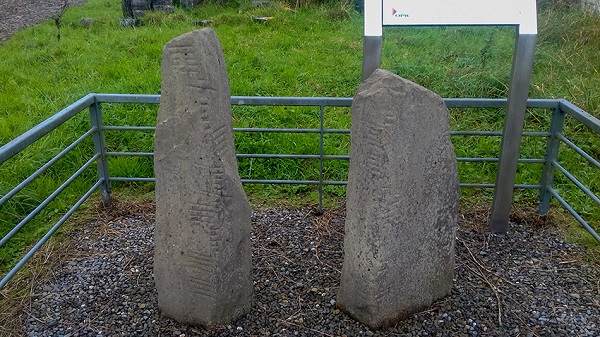Type: Ogham Stone
Townland: Tulaigh Ghearráin'Hill of the Garron' or 'Castrated Hill'

A storm at the end of the 18th century exposed 7 ogham stones, a possible fragment of an 8th ogham stone, a cross-inscribed stone, a number of graves and quantities of bone, and the ruins of several houses (Windele 1838, 145).
Windele's sketch of the site shows the ogham stones set out in a rough semi-circle on top of the mound with a slab-lined grave positioned nearby. Lord Ventry removed 6 of the ogham stones from the site in the mid-19th century; nos. 1 to 4 now line the driveway to Burnham House/Colaiste Íde (KE053-012004-, KE053-012005-, KE053-012006-, KE053-012007-), between Dingle and Ventry; nos. 5 and 6 are preserved in the grounds of Chute Hall (KE027-132----, KE027-241----) near Tralee and no. 7 remains at the original site (KE042-057003-).
The present location of this stone is at Chute Hall in the townland of Tullygarran and its monument number at that location is KE027-241----. This stone stands 1.1m high and is 0.29m x0.2m wide at base . Two opposed angles bear the inscription: CCICAMINI MAQQ(I) C(A)TTINI. Two of the vowels are no longer traceable but the remainder of the scores are clearly defined. (Cuppage 1986, no. 792 (No. 6))
Compiled by: Nora White for www.archaeology.ie
Currently situated at Chute Hall in the townland of Tullygarran.
Found:
Exposed by a storm at the end of the 18th century, along with 6 other ogham stones (Cuppage 1986, 250). Townland of Ballinrannig and barony of Corkaguiney. (GPS coordinates -10.388106, 52.178511)
Original:
Find location probably original site.
'Cillvickillane/Cill Mhic Uíleáin: A large, grass-grown,
sandy knoll, crowned by [this] single ogham stone, is located at
the base of a small promontory on the S shore of Smerwick Harbour.
It was here that a storm at the end of the 18th century exposed
7 ogham stones, a possible fragment of an ogham stone, a cross-inscribed
stone, a number of graves and quantities of bone, and the ruins
of several houses (Windele 1838, 145; Chatterton 1839, 190).
Windele's
sketch of the site shows the ogham stones set out in a rough semi-circle
on top of the mound with a slab-lined grave positioned nearby.
Chatterton
describes the houses as being beyond the mound nearer the sea. Windele
interpreted these as the remains of an ancient village, but it has
also been suggested that one of the structures, roughly 20 feet
x 12 feet (6 x 3.7m), was a church (Curran no. 21).
Lord Ventry
removed 6 of the ogham stones from the site in the mid-19th century;
nos. 1 to 4 now line the driveway to Burnham House/Colaiste Íde,
between Dingle and Ventry, and nos. 5 and 6 are preserved in the
grounds of Chute Hall near Tralee. Only no.7 is still preserved
on the original site'
(Cuppage 1986, 250-2).
1. Cuppage, J. 1986 Corca Dhuibhne. Dingle Peninsula archaeological survey. Ballyferriter. Oidhreacht Chorca Dhuibhne.
2. Macalister, R.A.S. 1945 Corpus inscriptionum insularum celticarum. Dublin. Stationery Office.
3. Macalister, R.A.S. 1897 Studies in Irish Epigraphy. A collection of revised readings of the ancient inscriptions of Ireland, with Introduction and Notes. London.
Further information about this site can be found
here:
Helena Zacharias.